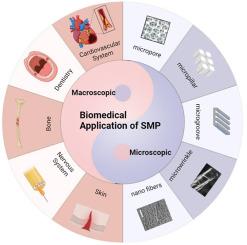生物医学用途的形状记忆聚合物的最新进展:桥接宏观和微观尺度效应
Q1 Engineering
引用次数: 0
摘要
形状记忆聚合物(SMPs)是一类能够在外界刺激下发生变形的材料,其独特的形状改变特性在生物医学领域的应用具有巨大的潜力。根据形状记忆效应的维度,变形可以分为宏观和微观两个层次。宏观变形使smp能够通过整体结构变化来发挥适应性、填充和支撑等功能。另一方面,微观变形涉及微纳米支架表面形态的动态调节,影响细胞形态,进而调节细胞行为和命运。无论是宏观还是微观,SME都能显著提高SMPs作为组织支架或医疗器械的性能。本文综述了SMP在生物医学领域的应用进展,重点从不同维度层面对SME进行了研究,并对未来的发展方向进行了展望。本文章由计算机程序翻译,如有差异,请以英文原文为准。

Recent advances in shape memory polymers for biomedical applications: Bridging macro- and micro-scale effects
Shape memory polymers (SMPs) are a class of materials capable of undergoing deformation in response to external stimuli, and their unique shape-changing properties offer vast potential for applications in the biomedical field. Based on the dimensionality of the shape memory effect (SME), deformation can be categorized into macroscopic and microscopic levels. Macroscopic deformation enables SMPs to perform functions such as adaptation, filling, and support through overall structural changes. On the other hand, microscopic deformation involves dynamic modulation of the surface morphology of micro- and nanoscale scaffolds, influencing cell morphology and further regulating cell behavior and fate. Whether at the macroscopic or microscopic level, SME significantly enhances the performance of SMPs as tissue scaffolds or medical devices. This review summarizes the progress of SMP applications in the biomedical field, focusing on SME at different dimensional levels, and provides insights into future development directions.
求助全文
通过发布文献求助,成功后即可免费获取论文全文。
去求助
来源期刊

Smart Materials in Medicine
Engineering-Biomedical Engineering
CiteScore
14.00
自引率
0.00%
发文量
41
审稿时长
48 days
 求助内容:
求助内容: 应助结果提醒方式:
应助结果提醒方式:


